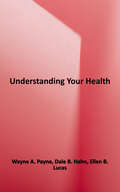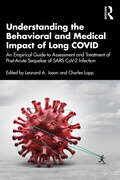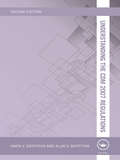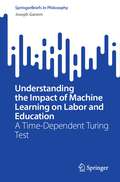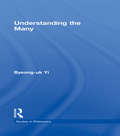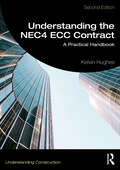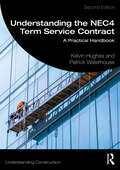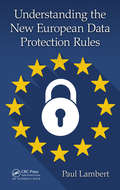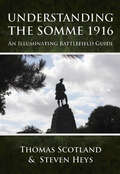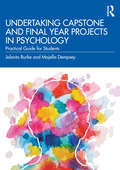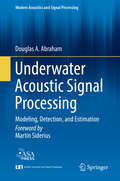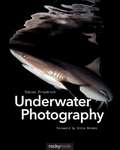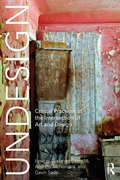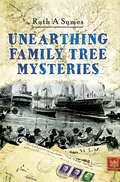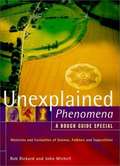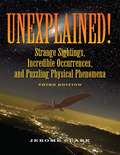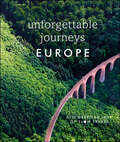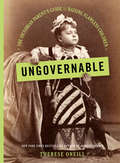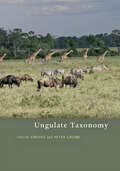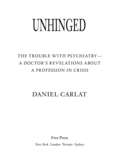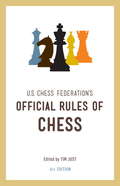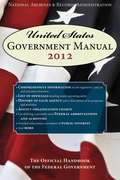- Table View
- List View
Understanding Your Health
by Dale B. Hahn Wayne A. Payne Ellen B. LucasThis book offers an exciting and practical approach to the teaching of the traditional content areas of personal health. Its two key themes - the six dimensions of health and the five developmental tasks - help students apply the text's content to their own lives, by improving their decision-making skills. The strength of the Understanding Your Health narrative includes its appeal to both traditional and non-traditional students, particularly the special attention it pays to students over age 25 who have returned to college. <p><p>In addition, among its many health assessment activities, Understanding Your Health includes one of the most comprehensive health assessments found in any personal health textbook - a great tool for establishing a health baseline for students. The companion Online Learning Center (website) offers a wealth of pedagogical and assessment features, including quizzes, Internet activities, downloadable MP3s, and more.
Understanding the Behavioral and Medical Impact of Long COVID: An Empirical Guide to Assessment and Treatment of Post-Acute Sequelae of SARS CoV-2 Infection
by Leonard A. Jason and Charles LappUnderstanding the Behavioral and Medical Impact of Long COVID serves to expand the research around the illness in order to enable health care researchers and practitioners to address the questions that are imperative to individuals suffering from this condition. Through its multi-faceted approach, the book puts forth a maturation of research and interventions that are theoretically sound, empirically valid, innovative, and creative in the Long COVID area. As a scholarly and scientific compilation of Long COVID symptoms and related disorders, this book offers unparalleled insight into the critical developments across medical areas treating this illness. It helps to fill the space that the pandemic had created for knowledge of the condition, and contributes to the emerging emphasis on translational research blending the social sciences and biological fields. By putting forth the most optimal medical care practices in the treatment of complex Long COVID symptoms, this practical anthology will serve as a guide for practicing clinicians in assessment as well as treatment. It will also benefit researchers aiming to gain more understanding of Long COVID through its discussion around the critical developments in other medical areas treating the condition, and paves the way for the collaboration and future research needed to best support the global effort to mitigate the effects of this illness. This book will be essential reading for academics, practitioners, and researchers. It will appeal to individuals engaging with the fields of medicine, public policy, psychology, and for researchers looking to gain clarity about our current understanding of Long COVID. It will further be of interest to public/government agencies, nonprofit organizations, and the general public wanting to gain more information about these ambiguous and evasive symptoms.
Understanding the CDM 2007 Regulations (Understanding Construction)
by Owen Griffiths Alun GriffithsAlmost 3000 lives have been lost in the UK construction industry over the last twenty-five years, in addition to those seriously injured or made ill. The need to reduce this rate has required tight controls to be introduced throughout the planning and management of construction projects in the UK. The Construction (Design and Management) Regulations 2007 outline the responsibilities and liabilities for the various professionals and agents involved. Straightforward and practical, Understanding the CDM 2007 Regulations demonstrates the rationale behind the regs, covers the duties of the five core duty holders (client, CDM coordinator, designer, principal contractor and contractor), explains the importance of the hazard management process on every project and also sets out the consequences of failing to successfully plan, design and manage for safety. Any client, architect, engineer, CDM co-ordinator, project manager, construction professional, or student will find this a simple but thorough and dependable guide and should value the management toolkit and the numerous practical examples of best practice and guidance on how to use the Approved Code of Practice appropriately. This book shows how to unleash the potential of the regulations and add real value to the industry.
Understanding the Impact of Machine Learning on Labor and Education: A Time-Dependent Turing Test (SpringerBriefs in Philosophy)
by Joseph GanemThis book provides a novel framework for understanding and revising labor markets and education policies in an era of machine learning. It posits that while learning and knowing both require thinking, learning is fundamentally different than knowing because it results in cognitive processes that change over time. Learning, in contrast to knowing, requires time and agency. Therefore, “learning algorithms”—that enable machines to modify their actions based on real-world experiences—are a fundamentally new form of artificial intelligence that have potential to be even more disruptive to labor markets than prior introductions of digital technology. To explore the difference between knowing and learning, Turing’s “Imitation Game,”—that he proposed as a test for machine thinking—is expanded to include time dependence. The arguments presented in the book introduce three novel concepts: (1) Comparative learning advantage: This is a concept analogous to comparative labor advantage but arises from the disparate times required to learn new knowledge bases/skillsets. It is argued that in the future, comparative learning advantages between humans and machines will determine their division of labor. (2) Two dimensions of job performance—expertise and interpersonal: Job tasks can be sorted into two broad categories. Tasks that require expertise have stable endpoints, which makes these tasks inherently repetitive and subject to automation. Tasks that are interpersonal are highly context-dependent and lack stable endpoints, which makes these tasks inherently non-routine. Humans compared to machines have a comparative learning advantage along the interpersonal dimension, which is increasing in value economically. (3) The Learning Game is a time-dependent version of Turing’s “Imitation Game.” It is more than a thought experiment. The “Learning Game” provides a mathematical framework with quantitative criteria for training and assessing comparative learning advantages. The book is highly interdisciplinary—presenting philosophical arguments in economics, artificial intelligence, and education. It also provides data, mathematical analysis, and testable criteria that researchers in these fields will find of practical use. The book calls for a rethinking of how labor markets operate and how the education system should prepare students for future jobs. It concludes with a list of counterintuitive recommendations for future education and labor policies that all stakeholders—employers, employees, educators, students, and political leaders—should heed.
Understanding the Many
by Byeong-uk YiFirst Published in 2002. Routledge is an imprint of Taylor & Francis, an informa company.
Understanding the NEC4 ECC Contract: A Practical Handbook (Understanding Construction)
by Kelvin HughesAs usage of the NEC family of contracts continues to grow worldwide, so does the importance of understanding its clauses and nuances to everyone working in the built environment. This second edition of Understanding the NEC4 ECC Contract uses plain English to lead the reader through the NEC4 Engineering and Construction Contract’s key features. Chapters cover: Contractor’s main responsibilities The use of early warnings Contractor’s design Tendering Quality management Payment Liabilities and insurance Termination Avoiding and resolving disputes and much more.Common problems experienced when using the Engineering and Construction Contract (ECC) are signalled to the reader throughout, and the correct way of reading each clause explained. The way the contract effects procurement processes, dispute resolution, project management and risk management are all addressed in order to direct the user to best practice. This second edition takes into account the updates to the contract released in 2019, 2020 and 2023, and brings the book up to date with the most current practice.Written for construction professionals, by a practicing international construction contract consultant, this handbook is the most straightforward, balanced and practical guide to the NEC4 ECC available. An ideal companion for employers, contractors, project managers, supervisors, engineers, architects, quantity surveyors, subcontractors and anyone else interested in working successfully with the NEC4 ECC.
Understanding the NEC4 ECC Contract: A Practical Handbook (Understanding Construction)
by Kelvin HughesAs usage of the NEC family of contracts continues to grow worldwide, so does the importance of understanding its clauses and nuances to everyone working in the built environment. This second edition of Understanding the NEC4 ECC Contract uses plain English to lead the reader through the NEC4 Engineering and Construction Contract’s key features. Chapters cover: Contractor’s main responsibilities The use of early warnings Contractor’s design Quality management Payment Liabilities and insurance Termination Avoiding and resolving disputes Tendering Common problems experienced when using the Engineering and Construction Contract (ECC) are signalled to the reader throughout, and the correct way of reading each clause explained. The way the contract effects procurement processes, dispute resolution, project management and risk management are all addressed in order to direct the user to best practice. This second edition takes into account the updates to the contract released in 2019, 2020 and 2023, and brings the book up to date with the most current practice.Written for construction professionals, by a practising international construction contract consultant, this handbook is the most straightforward, balanced and practical guide to the NEC4 ECC available. An ideal companion for employers, contractors, project managers, supervisors, engineers, architects, quantity surveyors, subcontractors and anyone else interested in working successfully with the NEC4 ECC.
Understanding the NEC4 Term Service Contract: A Practical Handbook (Understanding Construction)
by Kelvin Hughes Patrick WaterhouseUse of the NEC4 suite of contracts continues to grow and the new edition of Understanding the NEC4 Term Service Contract includes significant additional materials and changes since its original publication immediately after the initial release of the NEC4 contracts. Experienced authors and construction contracts specialists Kelvin Hughes and Patrick Waterhouse have added numerous practical experiences, case studies, lessons learned and guidance notes which were not available at the time of writing the original book.Covering all the recent updates to the contract and written in plain English, Understanding the NEC4 Term Service Contract offers a practical guide to the use and management of the NEC4 Term Service Contract (TSC). The authors describe the full life of a contract, from the initial selection of options and contract formation through to the operations period and ultimately termination and dispute resolution. Although born of the same stable as the NEC4 construction contracts, the TSC is aimed at maintaining infrastructure and differs significantly from its siblings.This is essential reading for anyone working with the contracts and takes the reader through the important provisions including communications, planning, early warnings, compensation events and payments. It is ideal for clients, contractors and their advisors describing how to deploy the contract successfully.
Understanding the New European Data Protection Rules
by Paul LambertCompared to the US, European data and privacy protection rules seem Draconian. The European rules apply to any enterprise doing business in the EU. The new rules are far more stringent than the last set. This book is a quick guide to the directives for companies, particularly US, that have to comply with them. Where US organizations and businesses who collect or receive EU personal data fail to comply with the rule, the bottom line can suffer from very significant official fines and penalties, as well as from users, customers or representative bodies to pursuing litigation. This guide is essential for all US enterprises who directly or indirectly deal with EU personal data.
Understanding the Somme 1916: An Illuminating Battlefield Guide
by Thomas Scotland Steven HeysThis is a guidebook with a difference. It is not a list of memorials and cemeteries. Its aim is to provide the reader with an understanding of the Battle of the Somme. There were some partial successes; there were many disastrous failures. In 17 concise chapters dealing with different areas of the battlefield and various aspects of strategy, this book explains what happened in each location and why. Each chapter is accompanied by color photographs, taken by the authors in the course of many visits to the Somme, which will illustrate, illuminate and allow the reader to understand important points made in the text. It doesn`t matter whether you are in your armchair, on foot, on a bicycle, or in a car, this book will effortlessly transport you to the battlefield and will sweep you round the front line of 1 July 1916. From Montauban in the south, to Serre in the north, it will lead you to the night attack of 14 July and to the first use of tanks on 15 September. It will take you to the Pozières Ridge and to Mouquet Farm, and to the heights above the Ancre. You will visit the famous Sunken Lane near Beaumont Hamel, where the text will transport you in time to stand with men from the 1st Lancashire Fusiliers waiting to go over the top on 1 July 1916. You will look towards Hawthorn Mine Crater and almost feel the earth tremble beneath your feet as though you were there at 07.20 hrs. on 1 July 1916. You will go into Beaumont Hamel with the 51st (Highland) Division and climb up Wagon Road. You will look across to where Frankfurt Trench once was, and where men from the 16th Highland Light Infantry from Glasgow fought a last ditch battle, having become marooned in the trench, in what was the last action to take place before the Somme finally petered out in the mud in late November 1916. With its focus on informing and illuminating the events of 1916 on the Somme, and illustrated throughout by carefully annotated color photographs showing the sites today, this book will prove equally essential to the battlefield visitor or the 'virtual visitor' in their armchair.
Understanding the Universe
by George GreensteinA student-active introduction to astronomy, emphasizing inquiry learning so students will clearly understand our universe and the scientific method. Within-text and end-of-chapter questions check understanding of concepts and require the student to think critically through astronomy-based problems. 'Nature of Science' and 'Detectives on the Case' sections in each chapter encourage students to take on the role of a scientist and so develop an understanding of how scientific progress is made, leading students through a chain of arguments of forming and testing hypotheses, in the context of specific astronomical topics. By focusing on key topics, the student is able to develop a deeper understanding of the core areas of astronomy. Math is used to make intuitive points and kept simple by using a two-track system to first describe the logic of the calculation followed by a more detailed example. Simple illustrations support the text and step students through concepts visually.
Undertaking Capstone and Final Year Projects in Psychology: Practical Guide for Students
by Jolanta Burke Majella DempseyUndertaking Capstone and Final Year Projects in Psychology serves a seminal purpose in guiding its readers to create a capstone project. The text employs traditional and emerging methodologies and methods in order to posit an exhaustive approach that the psychology students can adopt to see their project to fruition. The text aims at fortifying the reader’s skills through the structure of its chapters as they begin to work on their capstone or final year project. The chapters collectively explore the varied aspects that are involved in the completion of a final year project, that is, beginning from the inception of the idea to laying the foundation, designing the project, analysing the data, and, finally, presenting the findings. The text guides the reader through each step and provides further guidance on approaching the idea, coming up with the research question, positioning it within the epistemological and ontological context, and constructing the theoretical framework to arrive at the optimal design solutions. The text will be useful for psychology students who are currently completing a capstone or a final year project. It is further aimed at psychology students who will subsequently be working on a project and are looking forward to gaining cognisance regarding the approach and the methodology to be adopted for the same.
Underwater Acoustic Signal Processing: Modeling, Detection, And Estimation (Modern Acoustics and Signal Processing)
by Douglas A. AbrahamThis book provides comprehensive coverage of the detection and processing of signals in underwater acoustics. Background material on active and passive sonar systems, underwater acoustics, and statistical signal processing makes the book a self-contained and valuable resource for graduate students, researchers, and active practitioners alike. <P><P>Signal detection topics span a range of common signal types including signals of known form such as active sonar or communications signals; signals of unknown form, including passive sonar and narrowband signals; and transient signals such as marine mammal vocalizations. This text, along with its companion volume on beamforming, provides a thorough treatment of underwater acoustic signal processing that speaks to its author’s broad experience in the field.
Underwater Photography
by Tobias FriedrichUnderwater photography is a fascinating pursuit for those who aspire to capture the magical world found within our oceans and bring it to the surface. In this book, award-winning photographer Tobias Friedrich teaches us how to create stunning underwater images, covering everything from the equipment needed, to creating powerful compositions, to processing the final image. He uses case studies to show how his own images were created, and provides detailed explanations for specific techniques that can be applied to your very next dive.The text is supported by images from some of the most beautiful diving areas on Earth. Also included are countless tips and tricks for the beginner and intermediate photographer.Topics include:Choosing the right equipmentComposing your imagesWide-angle photographyMacro photographyImage editingCase studiesDiagrams of shooting positionsAn added bonus is the 22-page Guest Gallery featuring images by some of today's most recognized names in underwater photography, including Ernie Brooks, Alex Mustard, Richard Salas, Imran Ahmad, and Eric Cheng.The abundance of breathtaking underwater images contained in this book is sure to inspire you to plan your next dive.Foreword by Ernie Brooks.
Undesign: Critical Practices at the Intersection of Art and Design
by Andrew McNamara Gretchen Coombs Gavin SadeUndesign brings together leading artists, designers and theorists working at the intersection of art and design. The text focuses on design practices, and conceptual approaches, which challenge the traditional notion that design should emphasise its utility over aesthetic or other non-functional considerations. This publication brings to light emerging practices that consider the social, political and aesthetic potential of "undesigning" our complex designed world. In documenting these new developments, the book highlights the overlaps with science, engineering, biotechnology and hacktivism, which operate at the intersection of art and design.
Unearthing Family Tree Mysteries
by Ruth A. SymesThe intriguing characters in these real family history mysteries include an agricultural labourer who left secrets behind in Somerset when he migrated to Manchester, a working-class woman who bafflingly lost ten of her fourteen children in infancy, a miner who purportedly went to live with the Red Indians and a merchant prince of the Empire who was rumoured to have two wives. This book shows how a variety of sources including birth, marriage and death certificates, censuses, newspaper reports, passports, recipe books, trade directories, diaries and passenger lists were all used to uncover more, and how much can be detected by setting the characters from your family tree in their proper historical backgrounds.This book is an updated edition of Ruth Symes previous book, titled Stories From Your Family Tree: Researching Ancestors Within Living Memory (2008).
Unexplained Phenomena: A Rough Guide Special
by John Michell Bob RickardThis new title combines and updates two classic books ("Phenomena" and "Living Wonders") by the same authors. The original subjects of mysterious phenomena (including poltergeists, showers of objects and spontaneous human combustion) and crypto-zoology (including living ape men, the Loch Ness monster and dinosaurs in the Congo) has been joined by nine new sections covering subjects as diverse as vampires, crop circles and alien abductions.
Unexplained!
by Jerome ClarkDelivering the possible truths of more than 200 unexplained mysteries, this collection applies an authoritative, intelligent, and reasoned examination of strange artifacts and events that have perplexed scientists. It explores a wide range of phenomena, including cattle mutilations, crop circles, spontaneous human combustion, Martian lore, Roswell, Loch Ness, weather phenomena, fairies, Bigfoot, the Bermuda Triangle, living dinosaurs, ghosts, UFOs, pterodactyl sightings, flying humanoids, hollow earth, and other absorbing puzzles. Along the way, readers will learn of hoaxes, witness the creation of various modern myths, and learn of frightening personal accounts and startling historical documents. Documenting the evidence and hearing witnesses out, Jerome Clark brings an engaging narrative to the stories, objectively presents their many possible explanations, and lets the reader make his or her own judgment in this oneofakind book.
Unforgettable Journeys Europe: Discover the Joys of Slow Travel
by DKInspirational travel book covering 150 of Europe's most incredible journeys, including routes on foot and by bike, road, rail and water. When it comes to beautiful landscapes, Europe has more than its fair share of icons. The snowy peaks of the Alps, the vivid tulip fields of the Netherlands and the glittering lakes of northern Italy – you&’ll find them nowhere else but here. Yet pause to look around a little longer, and you&’ll soon discover that these postcard favorites sit side by side with many more understated scenes that are just as stunning. In fact, the slower you go, the more treasures you&’ll uncover – so why would you want to rush the experience? Featuring over 150 inspirational entries, Unforgettable Journeys Europe is a vibrant celebration of taking the scenic route. We've picked the best adventures across the continent, from cruising around the Western Fjords of Norway to hiking the Lycian Way in Turkey. Of course, the big-hitters are covered – riding Switzerland&’s Glacier Express, ferry-hopping in Greece and cycling from Land&’s End to John O&’Groats – but we also take you off-the-beaten path, roaming the Albanian Riviera, kayaking through Finnish lakeland and navigating the steady switchbacks of the Transfagarasan Road in Romania. Make your next trip magical as you explore: - Over 150 incredible journeys illustrated with inspiring photography and maps that plot the routes and bring their highlights to life.- Chapter maps provide a handy overview of the locations covered.- Evocative text transports the reader there with vivid descriptions and fascinating stories.- Includes practical information, such as duration, difficulty, and start and end points.- Sustainable and slow travel options have been covered where possible.- Feature boxes give the routes context.- Gives suggestions for alternative ways to make the same journey and other destinations where you can enjoy similar trips.We&’ve organized the book by types of transport, so whether you&’re an avid hiker, cyclist or driver, or love to be on the water or on the rails, we&’ve got you covered. It&’s time to take the slow road and truly appreciate Europe in all its wonderful variety.
Ungovernable: The Victorian Parent's Guide to Raising Flawless Children
by Therese OneillFrom the author of the "hysterically funny and unsettlingly fascinating"* New York Times bestseller Unmentionable, a hilarious illustrated guide to the secrets of Victorian child-rearing [*Jenny Lawson] Feminist historian Therese Oneill is back, to educate you on what to expect when you're expecting . . . a Victorian baby! In Ungovernable, Oneill conducts an unforgettable tour through the backwards, pseudoscientific, downright bizarre parenting fashions of the Victorians, advising us on: - How to be sure you're not too ugly, sickly, or stupid to breed- What positions and room decor will help you conceive a son- How much beer, wine, cyanide and heroin to consume while pregnant- How to select the best peasant teat for your child- Which foods won't turn your children into sexual deviants- And so much moreEndlessly surprising, wickedly funny, and filled with juicy historical tidbits and images, Ungovernable provides much-needed perspective on -- and comic relief from -- the age-old struggle to bring up baby.
Ungulate Taxonomy
by Colin Groves Peter GrubbA group of special interest to mammalogists, taxonomists, and systemicists, ungulates have proven difficult to classify. This comprehensive review of the taxonomic relationships of artiodactyls and perissodactyls brings forth new evidence in order to propose a theory of ungulate taxonomy.With this straightforward volume, Colin Groves and the late Peter Grubb cut through previous assumptions to define ungulate genera, species, and subspecies. The species-by-species accounts incorporate new molecular, cytogenetic, and morphological data, as well as the authors’ own observations and measurements. The authors include references and supporting arguments for new classifications.A starting point for further research, this book is sure to be discussed and hotly debated in the mammalogical community. A well-reasoned synthesis, Ungulate Taxonomy will be a defining volume for years to come.
Unhinged: A Doctor's Revelations About a Profession in Crisis
by Daniel CarlatIn this stirring and beautifully written wake-up call, psychiatrist Daniel Carlat exposes deeply disturbing problems plaguing his profession, revealing the ways it has abandoned its essential purpose: to understand the mind, so that psychiatrists can heal mental illness and not just treat symptoms. As he did in his hard-hitting and widely read New York Times Magazine article "Dr. Drug Rep," and as he continues to do in his popular watchdog newsletter, The Carlat Psychiatry Report, he writes with bracing honesty about how psychiatry has so largely forsaken the practice of talk therapy for the seductive and more lucrative practice of simply prescribing drugs, with a host of deeply troubling consequences. Psychiatrists have settled for treating symptoms rather than causes, embracing the apparent medical rigor of DSM diagnoses and prescription in place of learning the more challenging craft of therapeutic counseling, gaining only limited understanding of their patients lives. Talk therapy takes time, whereas the fifteen-minute "med check" allows for more patients and more insurance company reimbursement. Yet DSM diagnoses, he shows, are premised on a good deal less science than we would think. Writing from an insider's perspective, with refreshing forthrightness about his own daily struggles as a practitioner, Dr. Carlat shares a wealth of stories from his own practice and those of others that demonstrate the glaring shortcomings of the standard fifteen-minute patient visit. He also reveals the dangers of rampant diagnoses of bipolar disorder, ADHD, and other "popular" psychiatric disorders, and exposes the risks of the cocktails of medications so many patients are put on. Especially disturbing are the terrible consequences of over-prescription of drugs to children of ever younger ages. Taking us on a tour of the world of pharmaceutical marketing, he also reveals the inner workings of collusion between psychiatrists and drug companies. Concluding with a road map for exactly how the profession should be reformed, Unhinged is vital reading for all those in treatment or considering it, as well as a stirring call to action for the large community of psychiatrists themselves. As physicians and drug companies continue to work together in disquieting and harmful ways, and as diagnoses and misdiagnoses of mental disorders skyrocket, it's essential that Dr. Carlat's bold call for reform is heeded.
Unified English Braille: Australian Training Manual
by Josie Howse Kathy Riessen Leona HollowayUnified English Braille (UEB) was adopted for use by the Australian Braille Authority (ABA) in May 2005; with an envisaged five year transition period. Since 2010, it has been Australia's only braille code in use. Following the adoption of UEB, our major braille producers commenced implementing the code almost immediately and an urgent need for teaching materials in the new, but still developing, braille code was created. Thus, the Unified English Braille Primer: Australian Edition followed shortly afterwards, with the Preliminary Edition in 2006 and an update in 2008. As time passed, the UEB code has been refined and the UEB rules are now articulated in The Rules of Unified English Braille: Second Edition 2013 ("The Rulebook" as it is commonly known).
United States Chess Federation's Official Rules of Chess, Sixth Edition (Chess)
by U.S. Chess FederationThis comprehensive rulebook is the only guide sanctioned and compiled by the U.S. Chess Federation (USCF), the governing body for chess in the United States. It is designed to be a useful reference for all chess players, especially tournament directors and chess club teachers.THIS NEW EDITION FEATURES THE LATEST RULES GOVERNING CHESS, INCLUDING:• Guidelines for Internet chess and speed chess• Information about the USCF&’s national chess ratingsystem• Explanations of all legal moves• Guidelines for organizing and directing a tournament• A new and improved index for quick reference
United States Government Manual 2014: The Official Handbook of the Federal Government
by Records AdministrationThe United States Government Manual 2011-2012 provides up-to-date information about the activities of federal agencies, as well as the names of top officials in the Obama administration and U.S. senators and U.S. representatives.<P><P> You'll find information on the legislative, judicial, and executive branches, a list federal acronyms, and more. This special edition includes the contact information for each agency for employment, government contracts, publications, films, and other public services.
